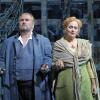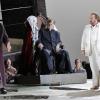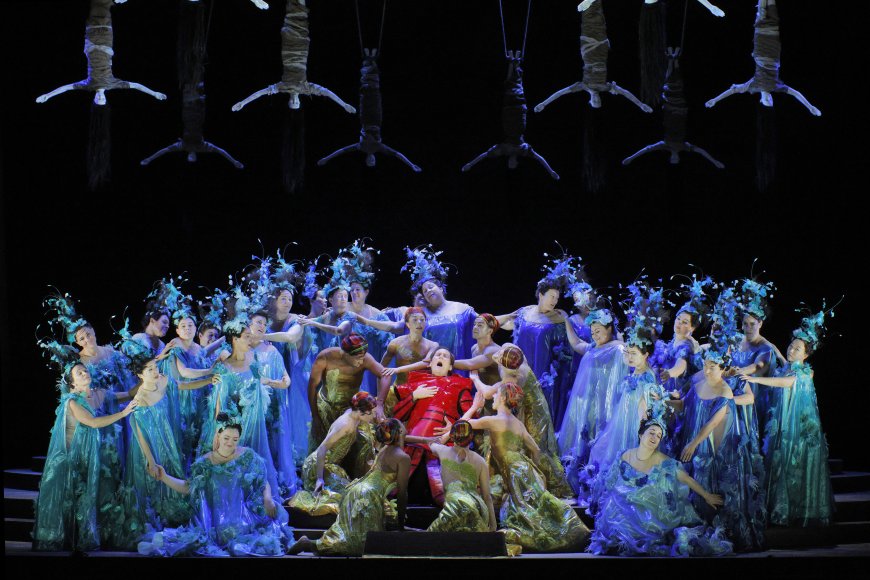
After a 25-year absence, Richard Wagner’s final opera, Parsifal, is back at San Francisco Opera in a musically and theatrically stunning new production.
It’s a triumph for Music Director Eun Sun Kim. After 2023’s Lohengrin and last year’s Tristan and Isolde, you could reasonably expect great work from Kim, and she delivers a powerhouse interpretation of subtlety and majesty. The orchestra is in tremendous form from the most transparent to the weightiest moments, playing together like a single gigantic instrument.
Director Matthew Ozawa’s productions of Beethoven’s Fidelio and Gluck’s Orpheus and Eurydice left strong and mostly positive impressions, but those operas are straightforward compared to the thickets a director must navigate in Parsifal. The director’s approach includes some interventions that literalists will object to; this reviewer found them dramatically keen and effective.
Wagner’s libretto, derived from Arthurian legends, Christianity, and Buddhism — a late interest of the composer — tells of an order of knights who guard the Holy Grail, a vessel imbued with miraculous powers and containing Jesus Christ’s blood, captured during the crucifixion.
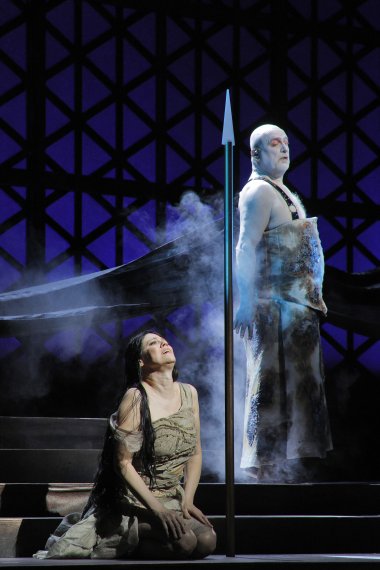
The drama hinges on whether an ignorant, loutish youth who wanders into the knights’ domain is the “pure fool” who, through compassion, might somehow heal the knights’ leader, Amfortas, who committed a great sin and now suffers from a wound that will not heal. We hear all about this, and more, from bass Kwangchul Youn as the wise old knight Gurnemanz, singing the long role in magnificent voice and with tremendous gravity and authority.
The plot follows the spiritual growth of the titular hero from ignorance to compassion. In Brandon Jovanovich, the production has an ideal Parsifal: his big, golden tenor voice combines with an earnest stage presence that makes his character’s path to enlightenment wholly believable.
That journey begins with his first entrance, when he shows some remorse after killing a swan. And during the long Act 1 Grail ceremony, where the knights partake of the Grail’s sustenance, Jovanovich radiates puzzlement and curiosity.
In Acts 1 and 3, Ozawa rises strikingly to the challenge of creating visual interest where there’s little action. The knights, dressed in shades of cream, stand arrayed on the rising concentric circles of Robert Innes Hopkins’s elegant set.
Three dancers, dressed in red robes and white headdresses, assist Amfortas (baritone Brian Mulligan, singing gorgeously, if a bit stolidly) during the Grail ceremonies, moving in graceful concert and enlivening the ritual. Are they handmaidens of the Grail? No one familiar with The Handmaid’s Tale can fail to make a connection between what they’re seeing and what’s in Margaret Atwood’s novel and its various dramatic adaptations, though the dancers’ behavior doesn’t reflect what’s in those works. Jessica Jahn’s beautiful and evocative costume designs, as well as Yuki Nakase Link’s moody lighting, do much to set the scenes effectively.
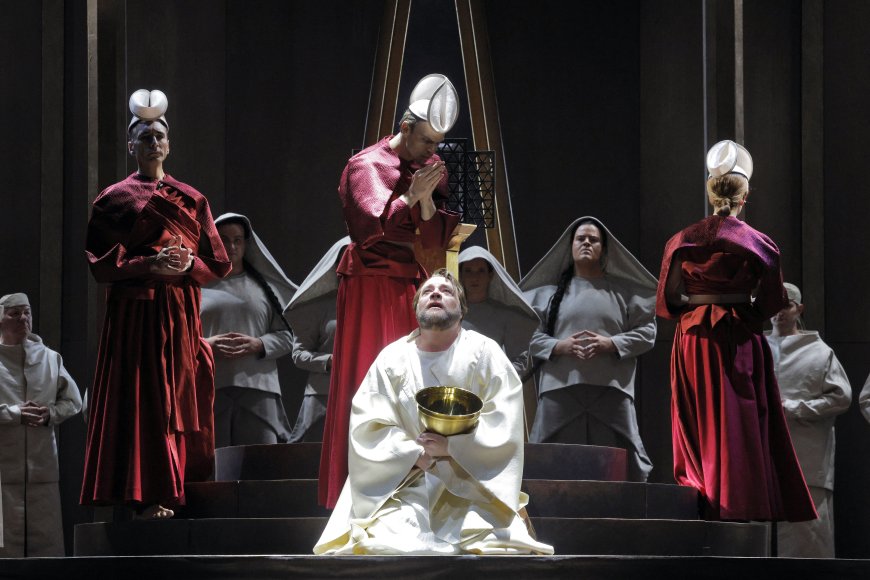
Act 2, by far the liveliest of the three, shows us the start of Parsifal’s journey to enlightenment. Now clad in medieval Japanese armor, he finds himself in the evil sorcerer Klingsor’s realm. Klingsor, wishing to become a Grail knight, castrated himself because he could not control his own sexual urges, but the knights rejected him. It is Klingsor who wounded Amfortas, using the knight’s own spear, a weapon that pierced the side of Jesus during the crucifixion.
Klingsor — bass-baritone Falk Struckmann, terrifyingly malevolent in voice and manner — has enslaved Kundry, a mysterious woman, hundreds of years old, who voluntarily serves the Grail knights, playing both sides of the opera’s good/evil equation.
Klingsor’s mostly bleak realm includes a magic garden inhabited by gorgeously costumed flower maidens, who try, as a group, to seduce Parsifal. Ozawa adds dancers, both male and female, to the maidens — and later in the act, Parsifal’s mother (dancer Charmaine Butcher).
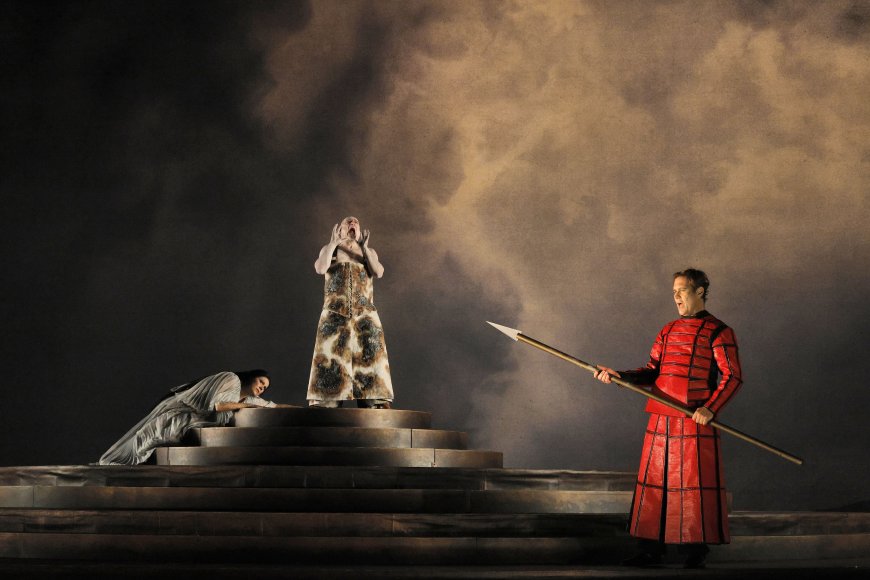
Failing to seduce him, Kundry curses Parsifal to years of wandering, and Klingsor tries to kill him. Parsifal catches the hurled spear, destroying the sorcerer and the realm. As in many productions, there’s no castle to collapse and thus no visual analog to the cataclysmic music.
At the opening performance, Jovanovich apparently suffered a vocal mishap during Parsifal’s climactic cry “Amfortas! Die Wunde!” (Amfortas, the wound!). He was somewhat diminished in volume and sang carefully through the rest of the opera.
In the last act of this nearly five-hour journey of transformation and transcendence Parsifal returns to the Grail’s realm, now blighted and decayed. It’s Good Friday, and Amfortas is unable to fulfill his office. Parsifal heals him with the spear and, taking over the ceremony, makes it clear that he is the new king of the knights. And in Ozawa’s feminist-inflected vision, he has a queen in the newly baptized Kundry.


